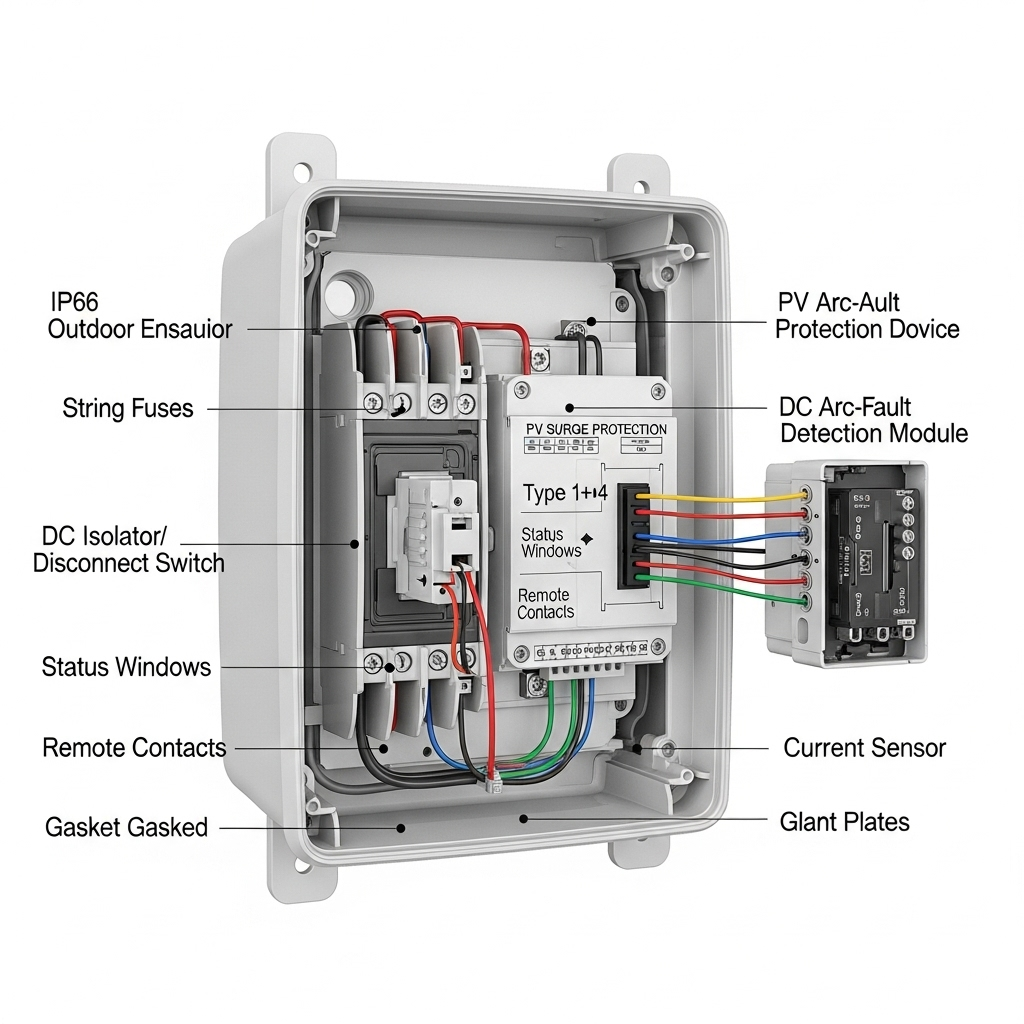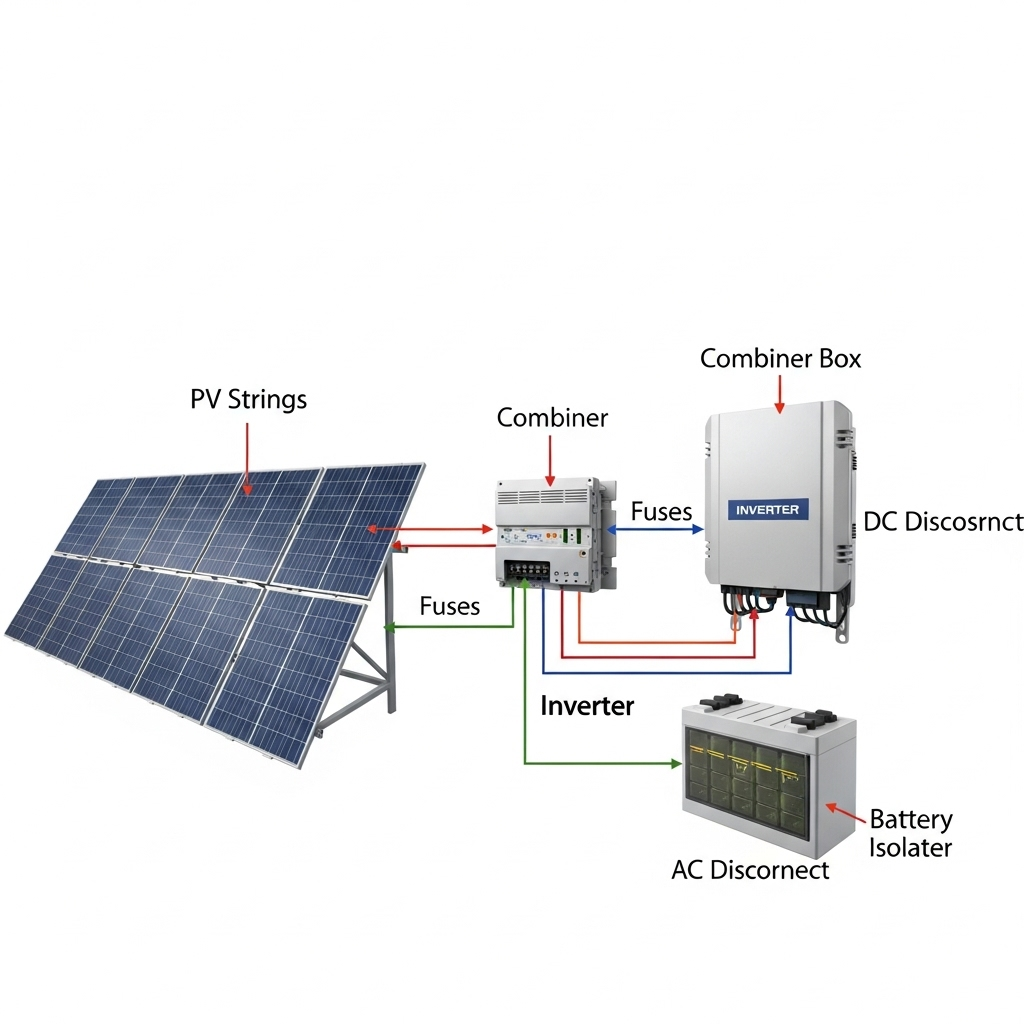You buy a combiner box to make strings neat and safe. You keep it for the next 20 years. Three choices decide how trouble-free that journey is: IP rating, surge protection, and arc-fault protection. This checklist gives clear steps to specify each item, align with codes, and avoid nuisance trips or early failures.
Why these three specs matter
IP rating keeps dust and water out. Surge protection clamps lightning and grid-induced transients. Arc-fault protection detects dangerous DC arcs early. Good choices cut call-outs, protect modules and inverters, and support safe isolation during service.
Grid requirements keep evolving. According to IRENA’s Grid Codes for Renewable Powered Systems, protection co‑ordination and communication capabilities are becoming more important as variable renewables grow. IEA’s work on system integration also highlights stricter power quality and fault behavior expectations for VRE plants. These trends reward combiner boxes that log events, coordinate with inverters, and maintain service under wider voltage and frequency excursions.
Quick buyer’s checklist (print and tick)
Enclosure and IP rating
- Target IP66 or higher outdoors; IP65 minimum under eaves. For coastal sites, prefer corrosion‑resistant materials and gasketed doors.
- Check UV‑stable gland fittings and spare cable entry capacity for future strings.
- Verify drain/vent features to manage condensation without losing the rating.
- Confirm ambient temperature range and derating for fuses, isolator, and SPD.
Surge protection (PV DC)
- Use PV‑rated Type 1+2 SPD near lightning‑exposed sites; Type 2 for low-risk areas. Select DC Uc ≥ 1.2 × array Voc_max (coldest day).
- Match In/Imax to site risk (e.g., 20–40 kA per pole for high exposure). Check let‑through voltage Up against inverter DC limits.
- Confirm thermal disconnector, visual indicator, and remote alarm contacts.
- Coordinate backup fusing per SPD datasheet and combiner layout.
Arc-fault protection (DC AFCI)
- Specify compliance with UL 1699B or IEC 63027 for PV DC arc detection.
- Ask for adjustable sensitivity, event timestamps, and self-test features.
- Ensure compatibility with inverter algorithms to avoid nuisance trips.
- Use shielded sensor wiring and clean cable routing to reduce EM noise.
Isolator and disconnect integration
- Front‑operated lockable DC isolator sized for array Isc × 1.25 continuous.
- Clear OFF indication; arc chambers rated for the system voltage (up to 1500 V).
- Mechanical interlock to prevent door opening under load (where required).
Documentation and compliance
- Wiring diagram, torque table, and SPD replacement procedure inside the door.
- Event log download path for O&M teams; spare SPD cartridges stocked.
- Compliance statement for applicable codes and standards. Non‑legal advice: verify with your AHJ and engineer of record.
IP rating: specify for rain, dust, and salt
Ingress protection is your first defense against downtime. For rooftop and ground‑mount PV, wind‑driven rain and dust enter through cable entries and door seams. The right IP rating plus the right cable glands closes those paths.
Match environment to IP rating
| IP rating | Typical location | Main risks addressed | Cable entry notes | Extra tips |
|---|---|---|---|---|
| IP54 | Indoor plant room | Dust, splashes | Conduit hubs preferable | Not for exposed roofs |
| IP65 | Under canopy/eaves | Dust, low-pressure water jets | Use IP68 glands for strings | Add sunshield for longevity |
| IP66 | Open outdoor wall/pole | Heavy jets, dust | Double-compression glands | Door gasket inspection yearly |
| IP67 | High splash, short immersion | Flood splash, dust | Potting or sealed gland plates | Watch heat buildup |
In coastal zones, choose stainless or powder‑coated aluminum with marine‑grade hardware. Add pressure equalization vents. Tight boxes trap moisture; controlled venting avoids gasket stress.
Energy.gov’s solar safety resources stress robust enclosures and proper cable management for reliable service in harsh climates.
Surge protection: clamp fast, coordinate well
A PV SPD must survive repeated surges and fail safe. Prioritize PV‑rated modules with thermal disconnects and pluggable cartridges. For isolator surge protection coordination, check both the SPD backup fuse size and the isolator’s short‑circuit withstand.
Ratings that matter
- Type: Type 1+2 for sites with external lightning protection or high keraunic levels; Type 2 for low to medium exposure.
- Uc (DC continuous voltage): select at least 1.2 × Voc_max at the site’s minimum temperature.
- In/Imax (nominal/max discharge current): size to exposure; higher Imax brings margin but watch let‑through Up.
- Up (voltage protection level): must sit below the inverter’s DC surge tolerance and component insulation limits.
- Mode: protect +/− to PE and + to − as per system grounding (floating or earthed arrays).
| PV system | Typical Voc_max | Suggested SPD Uc | In/Imax (per pole) | Notes |
|---|---|---|---|---|
| 600 Vdc | ≤ 660 V | ≥ 800 Vdc | In 20 kA / Imax 40 kA | Type 2 for low risk, Type 1+2 if LPS present |
| 1000 Vdc | ≤ 1100 V | ≥ 1200 Vdc | In 20–25 kA / Imax 40–50 kA | Pluggable cartridges ease O&M |
| 1500 Vdc | ≤ 1650 V | ≥ 1800 Vdc | In 25 kA / Imax 50–60 kA | Check Up vs inverter DC limits |
Place SPDs close to string inputs and the main DC bus inside the combiner. Keep leads short and twisted to reduce inductance. Bond the backplate to the enclosure and main earthing bar with low impedance.
IEA’s grid integration insights underline the need for robust fault behavior. Good surge coordination helps ride through disturbances without tripping protection unnecessarily.
Arc-fault protection: detect early, avoid nuisance trips
DC arcs start small and heat up fast. A dedicated PV arc-fault detection function monitors string current signatures and trips the disconnect before damage spreads.
What to ask from a PV DC AFCI
- Standard references: UL 1699B or IEC 63027 compliance statement and test report summary.
- Sensitivity bands and filtering to ignore inverter PWM noise while reacting to series arcs.
- Event logging with timestamps, string ID, and pre/post‑fault current snapshots.
- Self‑test pushbutton or periodic auto‑test to confirm sensor health.
- Clear alarm relay to SCADA or inverter DI for fast O&M response.
Digital features pay off. IEA’s Energy and AI report notes that fault detection and diagnosis improve reliability and reduce O&M effort. A combiner that stores arc‑fault events and exposes them over dry contacts or Modbus makes root‑cause analysis faster.
Worked selection: 12‑string rooftop, 1000 Vdc
Scenario: 12 strings on a commercial roof. Coldest site temperature −10°C. Module datasheet gives Voc at STC that leads to array Voc_max near 1050 V. Target: durable outdoor combiner with isolator, surge protection, and arc‑fault protection.
- IP rating: IP66 metal enclosure with UV‑stable glands, pressure vent, and sunshield.
- Isolator/disconnect: 1000 Vdc, 200 A, lockable, with door interlock.
- Fusing: 15 A gPV per string (check module Isc and string count).
- Surge protection: PV Type 1+2, Uc ≥ 1200 Vdc, In 20–25 kA, Imax 40–50 kA, Up below inverter DC surge limit. Backup fuse per SPD datasheet.
- Arc-fault: UL 1699B/IEC 63027 unit with adjustable thresholds, event log, and alarm relay to the inverter’s digital input.
Installation notes: keep SPD leads under 0.5 m, twist conductors, torque all lugs per the table inside the door. Schedule a functional test during commissioning and record baseline insulation and thermal images.
Storage coupling and hybrid systems
Many hybrid inverters sit next to a battery bank. Keep protection consistent across PV DC and the battery DC bus. Use a dedicated battery disconnect and short-circuit protection sized to the battery’s fault current capability. Surge exposure on the battery side is usually lower than the array side, yet sites with long DC runs or frequent switching may still benefit from DC SPDs.
For performance planning, see this practical reference on PV‑storage sizing and expected performance from our industry: Ultimate reference to solar storage performance. It compiles typical ranges for round‑trip efficiency and cycle life in LiFePO4 systems, which helps set protection and O&M expectations around hybrid deployments.
Why this aligns with evolving grid expectations
IRENA notes that modern grid codes emphasize protection co‑ordination, fault behavior, and communication. A combiner with proper surge protection and arc‑fault logging fits this direction. IEA research adds that operating ranges may broaden as systems decarbonize; resilient balance‑of‑system hardware supports stable operation during such events. For data‑driven O&M, the AI perspective from IEA’s Energy and AI supports using event logs and remote alarms to cut truck rolls. For market and reliability context, EIA publishes statistics that can frame site risk and outage costs.
O&M tips that prevent callbacks
- Quarterly: visual check on gasket health, gland tightness, corrosion, and SPD indicators.
- Semi‑annual: download arc‑fault and surge events; review for patterns.
- Annual: torque check, IR scan under full load, and SPD self‑test. Replace any SPD with a tripped indicator.
- After storms: quick SPD status check and insulation test on suspect strings.
Technical quick facts
- Keep wiring compact: every 10 cm of excess SPD lead can add tens of volts of let‑through.
- Choose isolators with DC arc chambers sized for your system voltage; AC switches alone do not suffice.
- Use double‑compression glands on moving or wind‑exposed cables to protect the IP rating.
Legal and safety notice
Non‑legal advice. Electrical work has risks. Always follow the latest editions of local codes and standards and consult a licensed professional. Site‑specific engineering may change the selections above.
FAQ
Do I need Type 1+2 or only Type 2 surge protection?
Sites with external lightning protection, tall buildings, or high lightning density benefit from Type 1+2 PV SPDs. Low‑risk sites often use Type 2. Check your site study and insurer requirements.
Is IP65 enough for rooftop combiners?
IP65 often works under eaves. For fully exposed roofs with wind‑driven rain, IP66 adds margin. In coastal zones, combine the rating with corrosion‑resistant materials and vents.
Will arc-fault protection trip during normal inverter operation?
Quality AFCI designs filter inverter switching noise and focus on arc signatures. Ask for compliance with UL 1699B or IEC 63027 and review nuisance trip records from similar projects.
How do isolators and SPDs interact?
Size the isolator for continuous load and short‑circuit duty, and the SPD for surge energy. Follow the SPD’s backup fuse recommendation so the thermal disconnector is protected. Keep leads short.
What if I plan to add storage later?
Pick a combiner with spare gland capacity and DIN rail space for extra SPDs or monitoring. The storage side needs its own DC disconnect and protection. Review hybrid inverter coordination in advance.





Leave a comment
All comments are moderated before being published.
This site is protected by hCaptcha and the hCaptcha Privacy Policy and Terms of Service apply.